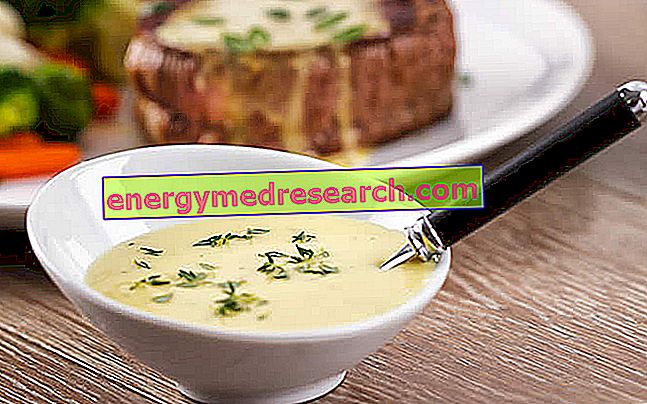Generality
The bernese sauce, or sauce béarnaise, is an emulsified seasoning based on clarified butter, egg yolk, shallots, tarragon, chervil, vinegar, salt and pepper; in practice, it is a variant of hollandaise sauce ( sauce hollandaise ).
The Bernese sauce is to be served lukewarm and is used to accompany roasted or pan-fried meats and fish (eg viande de boeuf Chateaubriand - beef fillet), but also boiled meat or fish or asparagus.

Nutritional Features
The Bernese sauce is a very caloric food, to be considered as a real seasoning fat. Its use must be strictly controlled and limited (if not avoided) in people suffering from overweight.
Nutritional values | |||||||||||||||||||||||||||||||||||||||||||||||||||||||||||||||||||||||||||||||||||||||||||||||||||||||||||||||||||||||||
 | |||||||||||||||||||||||||||||||||||||||||||||||||||||||||||||||||||||||||||||||||||||||||||||||||||||||||||||||||||||||||
| |||||||||||||||||||||||||||||||||||||||||||||||||||||||||||||||||||||||||||||||||||||||||||||||||||||||||||||||||||||||||
The proportion of energy lipids is extremely high, while proteins and carbohydrates (as well as fibers) are not very relevant.
The fatty acids that characterize the Bernese sauce tend to be saturated, as they come from butter and egg yolk. With regard to the cholesterol content, it too seems nothing short of exuberant. The lipid profile of the Bernese sauce suggests a moderate consumption for all, while it makes it completely discouraged in case of hypercholesterolemia.
As far as mineral salts are concerned, the Bernese sauce is rich in iron and zinc, while noteworthy concentrations are not evident in the other elements.
With regard to vitamins, on the other hand, they satisfy the levels of thiamine (vit. B1), riboflavin (vit. B2) and retinol equivalent (vit. A).
Background
Contrary to what the name suggests, the Bernese sauce is not from the city of Béarn, but from Paris.
It was created randomly on August 24th 1837 by Collinet, cook of the "Pavillon Henri IV" of Saint-Germain-en-Laye. Probably, the kitchen technician used a reduction of shallots to combine with egg yolk, creating an emulsion.
When customers asked for the name of this sauce, referring to Henry IV (of which a bust appeared inside the hall), Collinet improvised the words "Bernese sauce" (although probably the term was more closely linked to the origins of the birth of cook).
Bernese Sauce Recipe
The ingredients needed to package a Bernese sauce for 4-6 people are:
- 3 medium shallots,
- 1-2 fresh tarragon branches,
- 2 tablespoons of chervil ( Anthriscus cerefolium ),
- fine salt,
- ½ teaspoon of coarsely ground black pepper,
- 3 tablespoons of white vinegar,
- 4 egg yolks,
- 250g of fresh salted white butter.
The time required to prepare the Bernese sauce is about 25 '.
The procedure can be summarized as follows:
- Finely chop a shallot.
- Cut the tarragon and the chervil.
- Stew the shallot with a knob of butter for at least 5 minutes over a low heat.
- Add the vinegar, pepper and half of the aromatic herbs. Cook until the liquid is reduced to about two tablespoons.
- Introduce the yolks by whipping constantly and increasing the heat of the flame.
- Finally, add a piece of cold butter, pull down from the heat and continue whipping and adding the remaining herbs.
- The sauce can be kept warm in a bain-marie.
variants
- Choron sauce: add 1 to 1 of Bernese tomato paste
- Arlésienne sauce: add sardines to the Choron sauce
- Paloise sauce: replace the tarragon with mint
- Valois sauce: Bernese sauce concentrated with the addition of white wine.



